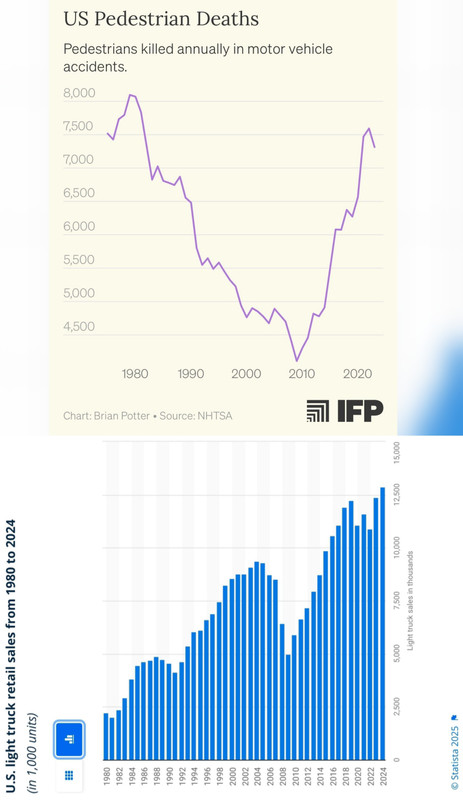I vaguelly remember reading how SUVs are 70% more deadly in collisions with pedestrians than conventional cars.
(Because their front is flatter and taller, so pedestrians are less likelly to roll over the hood and instead tend to be projected away)
I believe those kinds of cars started taking off back then.
People buy SUVs because “safer” but they kill more pedestrians - and they’re not strictly safer for occupants either. Big SUVs have rollover risk. Crossovers aren’t necessarily any safer in a collision because it turns out that what really matters is the “area” of the car (length x width) and since crossovers and SUVs often cost more, you end up getting a smaller vehicle by area for the same amount of money. You literally get less for your money and it’s also less fun to drive and probably requires more fuel. I honestly don’t see why people without back issues get crossovers over wagons.
I am mostly in agreement with you but why would the area of the car matter? You can potentially have bigger crumple zones, but that’d exclude the space that is used for passengers. Other than that, the energy transferred in a collision is relative to the mass, where the lighter vehicle receives a larger proportion of the energy than the heavier one.
Crumple zones are one thing, but also there might be more distance between you and the door in a bigger vehicle, etc. So somehow that’s how it scales
A crossover is the worst of both worlds
Phones may be a factor, but since this seems to be a uniquely North American problem, I’d look toward the vehicles themselves: People have always been distracted while walking, but hood heights have increased dramatically in recent years.
The drivers being on their phones is a major contributor, I’d imagine
Now that would be useful data. Can we confirm that?
Not quite what you’re looking for, but I never can resist an opportunity to post these:


Sure, those pictures are always shocking yet have clear meaning.
But cellphones happened everywhere, and people get distracted by them. I’m sure that’s _a_cause of increased accidents almost everywhere
But the truck issue is purely US (or is Canada infected too?). So comparing trends for is data vs other countries is a cheap way of separating the effect of cell phones vs the effect of excessive trucks
Car manufacturers skirting emissions regulations by selling “work trucks” instead of regular cars.
The increased size of these trucks directly causes more fatalities
Also giant lifted trucks
Everything is an SUV now
Even my wrx is a SUV now
What they did to the Lancer is criminal
Peel P5000
It’s true. The Ford mustang suv is an abomination
Yeah, the other mustangs call you unnatural when you put 600 foot-pounds of torque down to the ground in an instant, and not spin out of control into a crowd.
Wow that sounds so manly. Surley it will make me feel better about my incredibly small penis. Im off to the dealership.
It makes me feel better about mi…
Aaaay you got me! Nice job, you internet gigachad sigma male.
SUV’s were in before 2010 though.
Yes, some existed, but they didn’t dominate the roadways like they do now. There has been a sharp uptick of larger vehicles, all of which have higher hoods than the smaller cars they replaced, which make accidents against pedestrians more lethal, as well as reduce visibility to what’s immediately in front of the vehicle.
Assuming you’re referring to the US, the SUV explosion was spurred on by the cheap gas in the early 2000’s. Remember the Hummer? Like the H1 with the tank hatch on top? Those were only made until 2006, and the Hummer brand stopped making new vehicles in 2010. The Ford Excursion, the largest SUV ever made, was only made from 2000-2005. Absolutely, the proportion of large vehicles on the road has continued to grow massively, but they were still everywhere prior to 2010. Something else, like smartphones or statistical reporting practices, is more likely to be the cause of the 2010 uptick in this graph.
Yes, they started to increase production then, but sedans were still at least half of the market. They didn’t beat sales of sedans until more recently. [Here’s the first result in searching for “suv percentage by year”.] (https://www.theautopian.com/heres-the-exact-year-suv-sales-overtook-sedan-sales-in-america/)

I’m confused by the “Car SUV” vs “Truck SUV” numbers.
Aren’t a large majority of SUVs actually crossovers? And wouldn’t these crossovers be “Car SUV”? Your traditional truck-based SUVs are a minority.
Right, totally in agreement that their popularity has continued to grow since 2010. Now compare that graph to the graph in the post. SUVs didn’t just come out of nowhere in 2010, but the increase in pedestrian fatalities seemingly did. Therefore other factors besides just the popularity of large vehicles must have contributed to the massive increase in pedestrian fatalities.
2007/8 financial crisis had gas spike up to $5-8/gal in some instances. This caused a lot of people to sell their SUVs and get more economical vehicles.
In the mid 2010’s, gas prices came down substantially, and everyone bought more SUVs and traded in their economic vehicles.
SUVs kill pedestrians like bug zappers kill mosquitos on a damp, hot night in the swamp.
Drop starts in 1980, which was before SUVs, and after introduction of SUVs and popularity increase, kept dropping. I prefer the phone explanation, but don’t know why it started dropping in 1980. Maybe exodus to suburbs, and no pedestrians in suburbs?
I believe you might be trying to apply logic to the dates assuming there’s only one or two variables changing across all those decades. The truth is there are multiple strongly correlated reasons pedestrian deaths declined sharply in the US over the years.
In the 1980’s and 90’s it was largely the safety standards being improved in vehicles. ABS being standard helped with stopping before hitting people. Road safety standards and road designs improved to allow for more pedestrian walkways away from the streets. Automatic headlights at night turning on, better road conditions, better tires were introduced to handle different weather patterns more easily (e.g. in the rain or snow where traction loss could lead to pedestrian deaths) as well as standards to increase vehicle inspections and what safety standards were being checked during those inspections.
In the 2000’s, while many safety standards were still being improved and tweaked, a lot of the impactful ones had already been instituted, so the changes were less and less dramatic over the last 20ish years.
The specific question the OP was asking for was around the 2010 drop, and that is strongly correlated with high gas prices leading to sell-offs of SUVs, and SUVs are the leading cause of pedestrian deaths by far with modern cars with modern safety standards. Largely for the reasons others in this post have mentioned (larger, heavier, hood height, etc.).
I was very much a car nut during those years, and the gas prices drove many, many people to trade in their SUVs, trucks, etc. that had poor gas mileage. Gas prices were nuts, and a huge shock to everyone’s budget when it jumped up suddenly. This wasn’t really an inflationary thing, this was caused by a multitude of factors, but it stayed high for a long time due to those conditions.
When those conditions reverted, gas prices started falling like a rock, and everyone went back to thinking: “well, maybe I can afford that SUV again”. And they did. SUV sales rose sharply once gas prices fell. So pedestrian deaths have gone back up as a result.
Today, it’s also multiple factors, with the vehicle type being one of the large ones (hood height has been linked as a giant increase in the liklihood a pedestrian dies in a collision), but the other factor that rose sharply was smartphone use while driving from about the mid 2010’s to today. It’s probably the leading cause of vehicular deaths in general (I haven’t checked, but I’d throw $20 at it being distracted drivers).
We children of the 80s were out there in them streets, walking and biking to our friends’ houses and dodging the cars. Over the years our skills grew, and the numbers were finally on our side. And while it was sad on the rare occasion that we lost a friend to the streets as if they were an Oregon Trail character, it did help the numbers even more!
[https://www.statista.com/statistics/199980/us-truck-sales-since-1951/](If anyone is searching for an answer why.) Funny how it is almost the same curve.

Correlation is not causation
There could be a 3rd driving force that’s causing both trends, among other possible explanations
I think the general consensus is that bigger and more dangerous cars causes more pedestrian deaths.
I wouldn’t be surprised if that was the case
but a correlation (as presented in the first comment) is not a valid explanation (again, as is presented in the comment)
It’s good practice 👍🏼 but I probably go for the trucks explanation here
Why? The curves only correlate after 2010.
General increase in car ownership might explain both, more deaths and increased truck sales.
Truck sales were increasing until about 2007 but road deaths only rose since ~2010. So I think it is clearly different curves.
Trucks which are the most popular vehicles in the US got taller in the front
that’s also about the time “infotainment” systems started becoming common if not mandatory in cars. My 2003 S10 has physical switches for all of its controls, I can set the clock by feel. Newer cars with touch screen interfaces take drivers’ eyes off the road more than cars used to.
“Why is this happening” asks car obsessed, SUV infested country.
Compare with similar data in other countries and you’ll see the issue is not smartphones, and likely has more to do with your huge cars.
So what happened to all the huge cars in 2010?
we all rode bikes and walked everywhere in 2010 then they released cars 2
Hmm, Cars 2 was released in 2011, the same year it started shooting up. That can’t be a coincidence.
and see that little bump up before 2010? cars 1
There are probably several factors. I doubt there are as many people using a smartphone while driving in other countries. If someone wants to sit on their phone while commuting elsewhere, they can walk or take the train/bus/subway. In the US, you have to drive no matter what
Counterpoint, I wonder how much American culture makes people more willing to be in their phone while their vehicle is moving. The toxic work culture, the disregard for others, and so on likely contributes to a higher use of phone at dangerous times. Especially since larger cars are more about lethality.
What other developed countries have a 60+ hour work week in this day and age?
Edit: thought of a few in Asia but they all have public transportation so they can safely have their 1 hour “me time” commute. If Americans wanna play their mobile games to relax they have to do it in a car, oof.
60+ hour work week
You honestly believe that about America?
I haven’t worked 60 hours a week for over 20 years, and I was a contractor then, my time, my money. I’ve never met anyone that works 60 hour weeks, and no employer is paying that overtime. Maybe if you’re on salary at some insane tech startup? Maybe 2-3 people at my last gig (software dev) worked hours like that, but that was because they loved what they were doing. And HR frowned on that.
Most of the time they pay salary to avoid overtime, but that’s just in middle income scenarios. I didn’t say they were working only one job. People I know work two or three jobs to afford rent, easily taking up 60+ hours of their lives (or, a side hustle as they call it).
My brother got his drivers license that year…
How many more must die for his bloodlust to be satisfied!?
The size of cars exploded and bigger cars are less safe for pedestrians.
Smartphones in general happened. Suddenly, everyone could look at porn anywhere, anytime and were distracted.
And pickups grew about 2 feet taller.
Smartphones happened in Europe too, but deaths kept going down here.
Sex isn’t as taboo in Europe so being able to see porn all the time didn’t have an impact.
You’re really going all in on the porn angle huh?
I like porn. 🤷♂️
I’ve not seen people mention what probably is the actual case: the US government failing to handle the big changes in traffic like phone usage, change of vehicles sold, etc…
Different countries handled similar changes appropriately and deaths decreased, while the vehicle centric US did nothing to protect pedestrians/cyclists/…
The government, probably under influence from industry, is 100% to blame.
I just checked the data for Germany and it doesn’t reflect the same trend. Could be that Germany is more pedestrian friendly. There is no upwards trend visible from 2007, when smartphones became mainstream. But, you can see a clear drop in pedestrian
deathsaccidents caused by traffic during the pandemic.Edit: Little mistake from me, this statistic shows pedestrian accidents, not deaths. Still comparable though.

Why is this graph sideways
Its physically painful to look at.
i feel the same way every morning when i look in the mirror.
Stop doing what doesn’t serve you.
The more I look at it, the worse it gets
When corporate commands all charts must be up and to the right
There is an option to rotate it on the site, but it doesn’t work for me. Sorry about that.
This next question isn’t for you, but if you could pass it along to the website owners, that would be great.
WHAT THE HELL IS WRONG WITH YOUR GRAPHS??? WHY IS THE DEFAULT VIEW SIDEWAYS???
And the years are counting down.
Its German.
Because any values can be on X or Y axis.
99.9% of reasonable graph makers put the linear value (like years) on the x axis, and the variable value on the y axis…
I guess Germany isn’t as much into SUVs
What in the ever living abscissa is this graph?
Could also be a mentality thing, if you can mentally put down the phone and not text. Or hell an automatic/manual transmission thing, can’t use the phone if you have to shift.
LED headlights that blind everybody in front of them














